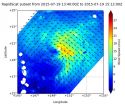(Press-News.org) JACKSONVILLE, Fla. -- Researchers on Mayo Clinic's Florida campus have identified key differences between patients with sporadic amyotrophic lateral sclerosis (ALS or Lou Gehrig's disease) and those with the most common genetic form of ALS, a mutation in the C9orf72 gene.
Their findings, reported online today in Nature Neuroscience, demonstrate that ALS patients show abnormalities in levels and processing of ribonucleic acids (RNA), biological molecules that determine what gene information is used to guide protein synthesis.
More than 30,000 Americans live with ALS, a condition that destroys motor neuron cells that control essential muscle activity, such as speaking, walking, breathing and swallowing. While increasing efforts are geared toward therapeutic development, an effective drug for ALS has yet to be identified, in large part because of our incomplete understanding of the disease.
"Our results using advanced, modern laboratory techniques called next-generation sequencing, allowed us to acquire a library of new knowledge about patients with ALS," says the study's senior author, Leonard Petrucelli, Ph.D., chair of the Department of Neuroscience on Mayo Clinic's Florida campus.
Dr. Petrucelli and Hu Li, Ph.D., assistant professor of pharmacology on Mayo Clinic's campus in Rochester, Minn., led a team of investigators who carefully analyzed the RNA from human brain tissues. They found that ALS brains had numerous RNA defects, compared to nondisease brains. They also predicted molecular events that may be altered due to the changes found in RNAs involved in pathways regulating those events and that may contribute to ALS.
While the researchers observed some commonalities, they also found many distinctions between the RNAs that were altered in sporadic versus C9orf72 mutation-associated cases. This suggests there may be different factors contributing to ALS in patients. The success of future therapies may need specific tailoring to the specific root cause of a patient's motor neuron disease. Furthermore, the large volume of data obtained from their study, which was deposited into a public genomics data repository, provides a wealth of information available to other researchers to accelerate ALS research.
Key to the success of their study was procuring samples from individuals who generously donated their tissues for research purposes to the Mayo Clinic after their passing. Close collaborations among the Petrucelli laboratory, Kevin Boylan, M.D., director of the ALS Certified Center of Excellence on Mayo's Florida campus, and Dennis Dickson, M.D., director of the neuropathology laboratory on the Florida campus, facilitated access to these precious samples.
"Last year, the ALS Ice Bucket Challenge raised a remarkable amount of money to support ALS patients and research," Dr. Petrucelli says. "Without the extreme generosity of both monetary donors and patient tissue donors we could not make these strides in understanding this devastating disease."
The Petrucelli laboratory is conducting follow-up studies based on the data from this study to determine which alterations are important in ALS pathogenesis. The researchers also will study which alterations should be developed as diagnostic and prognostic biomarkers or as therapeutic targets that may offer hope to patients with ALS.
INFORMATION:
This work was supported by the National Institutes of Health/National Institute on Aging (R01AG026251 and P50AG016574); the National Institutes of Health/National Institute of Neurological Disorders and Stroke (R21NS089979; R21NS084528, R01NS088689; R01NS077402; R01NS063964; P01NS084974); the National Institute of Environmental Health Sciences (R01ES20395); the Department of Defense (ALSRP AL130125); Mayo Clinic Foundation; Mayo Clinic Center for Individualized Medicine; ALS Association; Robert Packard Center for ALS Research at Johns Hopkins; Target ALS; Canadian Institutes of Health Research; Siragusa Foundation; Robert and Clarice Smith and Abigail Van Buren Alzheimer's Disease Research Foundation; and Donors Cure Foundation.
About Mayo Clinic
Mayo Clinic is a nonprofit organization committed to medical research and education, and providing expert, whole-person care to everyone who needs healing. For more information, visit mayoclinic.com or newsnetwork.mayoclinic.org.
MEDIA CONTACT: Kevin Punsky, Mayo Clinic Public Affairs, 904-953-0746, punsky.kevin@mayo.edu
VANCOUVER, B.C. and DURHAM, N.C. - Results from HPTN 067, a Phase II, randomized, open-label study, demonstrate most study participants had higher coverage of sex events and better adherence when they were assigned to the daily dosing arm, investigators from the HIV Prevention Trials Network (HPTN) reported today at the 8th International AIDS Society (IAS) Conference on HIV Pathogenesis, Treatment and Prevention in Vancouver, Canada. HPTN 067, also known as the ADAPT Study, was designed to evaluate the feasibility of non-daily pre-exposure prophylaxis (PrEP) regimens. The ...
VANCOUVER, B.C. and DURHAM, N.C. - Antiretroviral therapy (ART) for HIV infection provides lasting protection against the sexual transmission of the virus from infected men and women to their HIV-uninfected sexual partners, investigators from the HIV Prevention Trials Network (HPTN) reported today at the 8th International AIDS Society (IAS) Conference on HIV Pathogenesis, Treatment and Prevention in Vancouver, Canada.
The study, known as HPTN 052, began in 2005 and enrolled 1,763 HIV sero-discordant couples - where one person is HIV-infected and the other is not - at 13 ...
WASHINGTON --Emergency physicians can safely reduce x-rays in children with hurt ankles by as much as 23 percent and save emergency patients both money and time. The results of a cost analysis of the Low Risk Ankle Rule (LRAR) were published online Tuesday in Annals of Emergency Medicine "Cost Consequence Analysis of Implementing the Low Risk Ankle Rule in Emergency Departments".
"Currently, x-rays are ordered for up to 95 percent of children who come to emergency departments with ankle injuries, though only 12 percent of those x-rays show fractures," said lead study ...
Solar panels are an investment -- not only in terms of money, but also energy. It takes energy to mine, process and purify raw materials, and then to manufacture and install the final product.
Silicon-based panels, which dominate the market for solar power, usually need about two years to return this energy investment. But for technology made with perovskites -- a class of materials causing quite a buzz in the solar research community -- the energy payback time could be as quick as two to three months.
By this metric, perovskite modules are better than any solar technology ...
Tropical Depression Halola is getting stronger. NASA data pinpointed the area of strongest sustained winds on July 19 and the extent of those winds expanded on July 20 as Halola became a tropical storm again. NASA also gathered infrared data that showed cloud top temperatures getting colder, indicating more uplift or strength in the storm.
On July 19 at 2 p.m. GMT (10 a.m. EDT), the RapidScat instrument aboard the International Space Station gathered data on surface winds in Tropical Depression Halola. RapidScat saw the strongest sustained winds were on the northeastern ...
Antiretroviral treatment that consistently suppresses HIV is highly effective at preventing sexual transmission of the virus in heterosexual couples where one person is HIV-infected and the other is not, investigators report today at the 8th International AIDS Society Conference on HIV Pathogenesis, Treatment & Prevention (IAS 2015) in Vancouver, Canada. The finding comes from the decade-long HPTN 052 clinical trial funded primarily by the National Institute of Allergy and Infectious Diseases (NIAID), part of the National Institutes of Health, and conducted by the NIH-funded ...
Researchers from the University of Copenhagen have discovered a way of improving biotech drugs. Better, cheaper and more effective drugs to combat cancer, arthritis and many other disorders.
This is the result of a ground-breaking new technique developed by a group of researchers from the Faculty of Health and Medical Sciences at the University of Copenhagen.
The method can improve a large number of so-called glycoprotein-based pharmaceuticals used to treat a variety of diseases. The technique has recently been described in one of the world's most distinguished scientific ...
No one likes to lose a friend, especially adolescents. But why do friendships end? Researchers in the Charles E. Schmidt College of Science at Florida Atlantic University sought to answer this question with a study examining whether adolescent friendships end because of undesirable characteristics of friends, because of differences between friends, or both. Findings from this long-term longitudinal study of 410 adolescents involved in 573 friendships are published in the current issue of Psychological Science.
Adolescent friendships are fleeting. The majority dissolve ...
WASHINGTON, July 20, 2015 -- If you're stumped in the wine aisle of the store, then you're not alone. Every bottle has unique nuances of taste and smell. How can something made of grapes smell buttery or taste like grass? Learn about the complex chemistry behind wine and then impress your friends at your next party thanks to Reactions. Check out our wine chemistry primer here: http://youtu.be/_UaS743_aEs.
Subscribe to the series at http://bit.ly/ACSReactions, and follow us on Twitter @ACSreactions to be the first to see our latest videos.
INFORMATION:
The American ...
Nearly a third of breast cancer survivors in Appalachia are not taking the critical, potentially life-saving follow-up treatment - despite having insurance that would pay for it, a troubling new study has found.
Researchers cross-examined cancer registries with Medicare claims data and determined that of 428 women, approximately 30 percent failed to follow through with their prescribed adjuvant hormone therapy, a treatment to prevent the cancer's recurrence.
"Almost a third of the prescriptions for adjuvant hormone therapy were not filled, which is much, much higher ...

